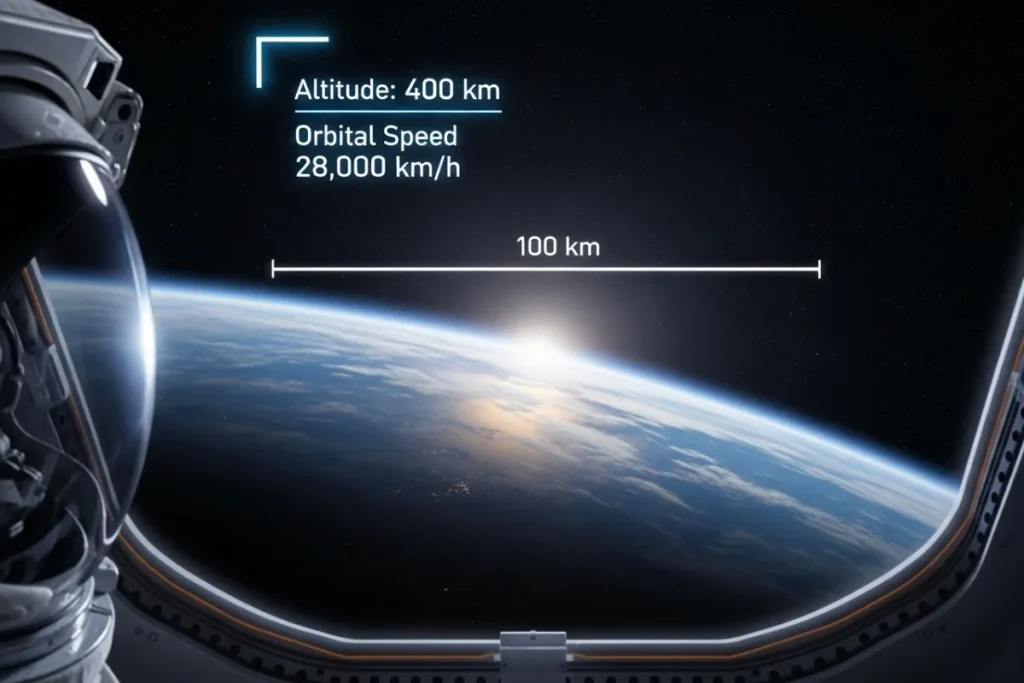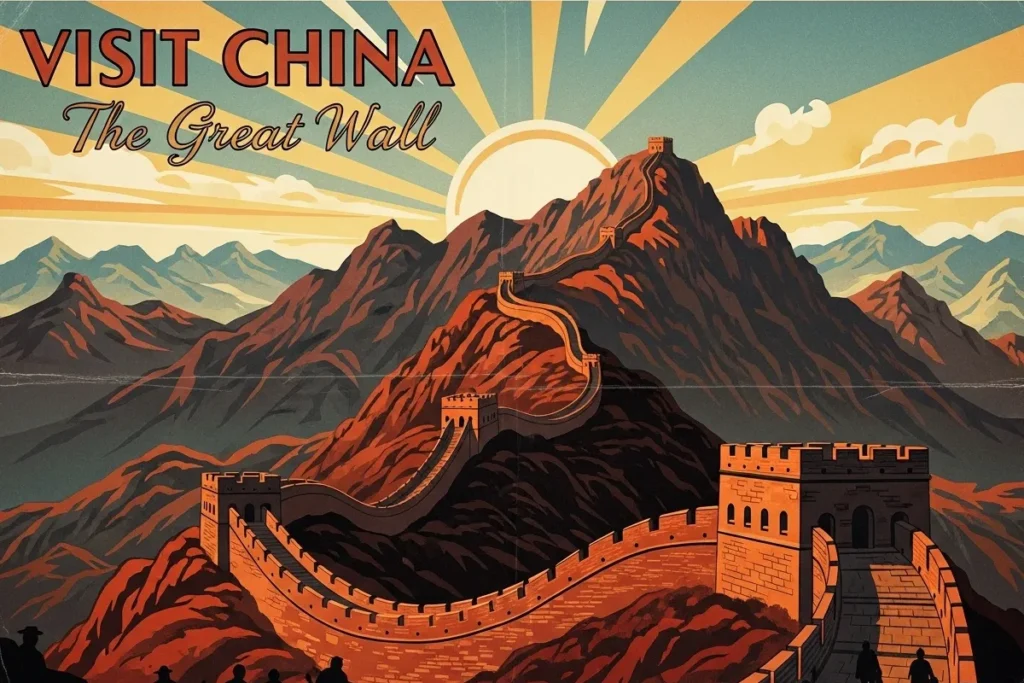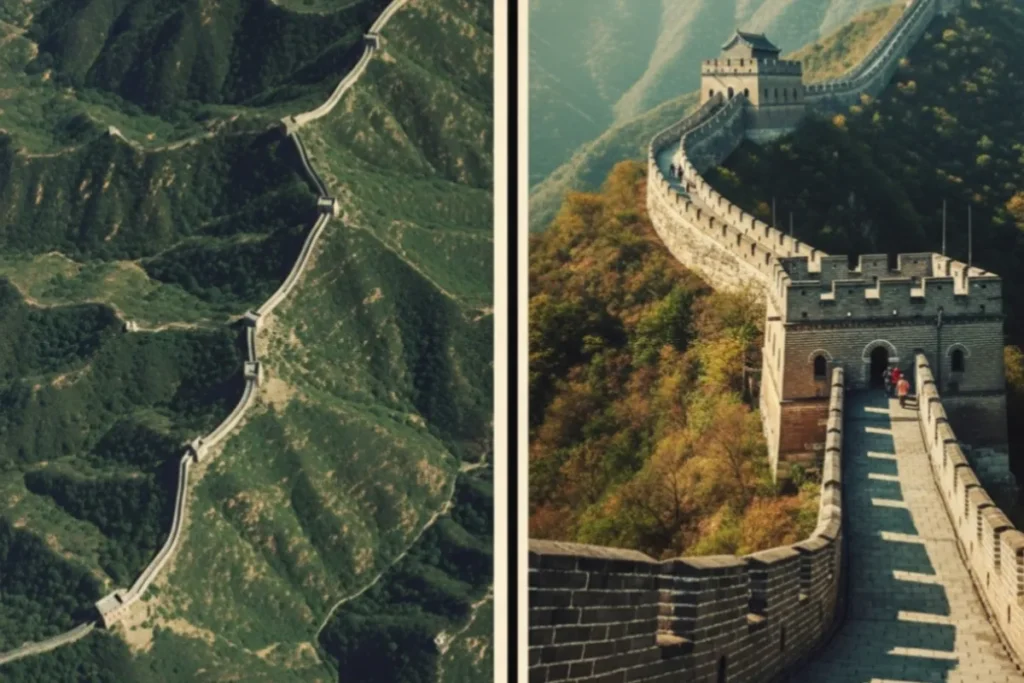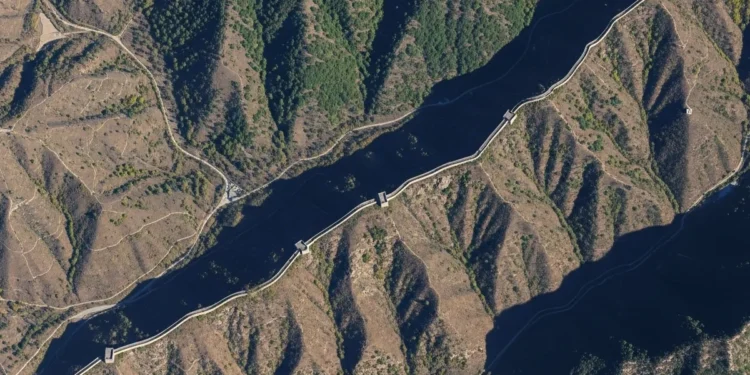Explores the Great Wall Myth’s photographic origins, modern astronaut testimony, media repetition, and why the phrase endures despite satellite imagery and optics explanations.
Table of Contents
Introduction
The Great Wall Myth is one of history’s most stubborn and romanticized falsehoods. It’s a grand assertion, repeated in classrooms and travel guides for over a century: that a single human creation is so immense, it can be seen from the moon, or at the very least from space, with the naked eye. It’s a story that feels true, a testament to human ambition written on the face of the planet. The only problem is that it’s entirely false. Not a single astronaut has ever seen it from the moon, and even from the close confines of low Earth orbit, it remains stubbornly invisible.
This isn’t just a simple mistake; it’s a cultural phenomenon that reveals far more about our psychology and love for a good story than it does about geography or the limits of human vision. The flawed Great Wall Myth thrives in the space between scientific reality and our collective imagination. Its resilience in an age of instant fact-checking and high-resolution satellite imagery is a fascinating case study in how a powerful narrative can become more real than reality itself. Understanding why we cling to this tale is to understand how we process ideas of scale, legacy, and our own place in the universe.
To unpack its enduring power, this article will deconstruct the consequences of the Great Wall Myth from its very beginning. We will trace its origins to a speculative 19th-century illustration and its popularization by Ripley’s Believe It or Not!. We’ll then listen to the definitive testimony from the astronauts who actually looked for it, explore the clear science of space optics that makes its visibility impossible, and examine how modern media became its life support system. Finally, we will analyze why this beautiful lie continues to feel more true than the facts, surviving as a potent metaphor for human achievement.
The Photographic Lie: How an Old Illustration Birthed the Myth
Long before humanity slipped the bonds of Earth’s gravity, the Great Wall Myth was already a well-established piece of popular fiction. Its origins can be traced not to a photograph from orbit, but to the speculative illustrations of the late 19th century. In an 1893 issue of The Century magazine, a drawing depicted the Wall, accompanied by a caption that mused about its immense scale. This seed of an idea was later seized upon and amplified by Robert Ripley, who featured the claim in his Ripley’s Believe It or Not! cartoon panel in 1932, declaring the Wall was “the mightiest work of man—the only one that would be visible to the human eye from the moon.”
This assertion was, of course, entirely baseless, yet it perfectly captured the public’s imagination. The sheer scale and ambition of the Great Wall made the claim feel plausible. In an era captivated by monumental engineering feats, the idea that one was so grand it could be seen from another celestial body was an irresistible narrative. The flawed Great Wall Myth tapped into a collective sense of human achievement, transforming a defensive structure into a symbol of mankind’s mark upon the planet itself. It was a romantic notion that resonated deeply, and it required no proof to gain momentum.
The claim’s repetition in a trusted, popular source like Ripley’s cemented its status as fact for millions of readers. For decades, it was recycled in books, classrooms, and conversations without question. This pre-spaceflight acceptance is crucial to understanding the endurance of the Great Wall Myth. It wasn’t a conclusion drawn from evidence, but a piece of folklore that grew to fill a vacuum of knowledge about what Earth actually looked like from afar. The consequences of the Great Wall Myth were already in motion, establishing a powerful cultural belief long before any astronaut could look down and report back the truth.

Voices from Orbit: What Astronauts Actually See
Once humans reached orbit, they had the chance to test the Great Wall Myth with their own eyes. The verdict was overwhelmingly clear. Apollo 12 astronaut Alan Bean, recalling his journey, stated, “The only thing you can see from the moon is a beautiful sphere, mostly white, some blue and patches of yellow, and every once in a while some green vegetation.” Neil Armstrong confirmed that even from low Earth orbit, the Wall was certainly not visible. Perhaps most definitively, China’s own first astronaut, Yang Liwei, admitted his disappointment in 2003, stating he could not see the fabled structure from space, a significant moment in rethinking the Great Wall Myth.
The narrative is slightly complicated by a few astronauts who claimed to have spotted it, which keeps the debate alive. U.S. astronaut Eugene Cernan said, “In Earth orbit, a lot of things are visible. You can see highways, you can see runways… I’m not so sure I couldn’t see the Great Wall.” More recently, astronaut Leroy Chiao claimed to have captured it with a telephoto lens. These isolated astronaut quotes Great Wall sightings, however, come with critical caveats: they required powerful magnification, near-perfect weather conditions, and the astronaut knowing precisely where to look. This is a far cry from the naked-eye visibility promised by the flawed Great Wall Myth.
For proper context, it’s more useful to consider what astronauts can easily see. From low orbit, man-made objects like airport runways, dams, and even large ships at sea are sometimes visible due to their high contrast with their surroundings. The checkerboard patterns of irrigated farmland and the bright spiderwebs of city lights on the night side of Earth are far more prominent features. The Great Wall, by contrast, is made of materials that blend almost perfectly with the land it traverses. The truth from those who have actually been there is that our planet displays many wonders from above, but the Great Wall is simply not one of them.
The Science of Sight: Why Space Optics Make the Wall Invisible
The persistence of the Great Wall Myth flies in the face of basic physics and the science of optics. For an object to be visible to the naked eye from a distance, it needs two things: sufficient size and high contrast against its background. The Great Wall of China possesses neither. From low Earth orbit, which is at a minimum altitude of about 100 miles (160 km), the human eye can resolve objects with a contrast of about 100 to 200 feet. This fundamental limitation is at the heart of the space optics myth; the Wall is simply far too narrow to register.
The core problem lies in the Wall’s dimensions and materials. While it is incredibly long, it is, on average, only about 20 to 30 feet (6-9 meters) wide. Furthermore, its construction from local stone and earth gives it a color palette that is nearly identical to the surrounding landscape. It doesn’t stand out; it blends in. Satellite photography facts confirm this: even high-resolution satellite cameras require ideal lighting conditions and specific angles to clearly distinguish the Wall from the mountains it traverses. It is not a distinct, high-contrast line like a river or a highway cutting through a desert.
To put this into perspective, attempting to see the Great Wall from orbit is the optical equivalent of trying to spot a single human hair from a distance of two miles. It’s an impossible task. No matter how culturally significant or historically massive an object is, it cannot defy the physical laws of light and perception. The Great Wall Myth endures not because of any visual reality, but because our imagination wants to believe that such a monumental human effort would leave a mark visible even from the heavens. Science, however, tells a different, clearer story.

Media and Repetition: The Myth’s Modern Life Support
If the Great Wall Myth was born from a 19th-century illustration, it was raised and nurtured by 20th-century media. For generations, textbooks, encyclopedias, and travel documentaries repeated the claim as an undisputed fact. It became a staple of classroom trivia and a go-to “amazing fact” for educators and journalists alike. This uncritical repetition by trusted sources is what transformed a piece of folklore into a globally accepted truth. The sheer volume of reinforcement made the myth feel solid and unassailable, cementing the Great Wall visibility claim in the collective consciousness long before the internet provided easy tools for fact-checking.
The digital age created a paradox for the Great Wall Myth. On one hand, a simple search provides immediate access to astronaut testimony and scientific explanations that thoroughly debunk the claim. Yet, the same internet ecosystem allows the myth to spread faster than ever. It persists in blog posts, travel forums, and viral social media shares, often stripped of any nuance. Misinformation, especially a story as captivating as this one, travels more quickly than its correction. The myth’s digital life support system runs on clicks and shares, favoring a sensational narrative over a more complex and mundane reality.
This speaks to a fundamental aspect of human psychology: we love a good story, and we are wired to believe and share information that inspires awe. The idea of a man-made structure being visible from space is simply more compelling than a lesson in orbital optics. This “fact” became a piece of cultural currency, a shorthand for something of immense scale and significance. The persistence of the Great Wall Myth, therefore, is less about a failure of education and more about the triumph of a powerful narrative that we, as a society, have chosen to keep alive.
More Than a Myth: Why This “Harmless” Tale Endures
To dismiss the Great Wall Myth as a simple error is to miss the point of its extraordinary persistence. Its power has never been rooted in scientific accuracy, but in its profound symbolic meaning. The myth transforms the Great Wall from a mere historical structure into a testament to humanity’s collective will, a symbol of our ability to achieve the impossible and leave a permanent mark on the world. It speaks to a deep-seated desire to believe that our greatest works have a significance that transcends earthly bounds. The story endures because it’s not really about the Wall; it’s about us.
The phrase itself has evolved beyond its literal claim. When we say something is “the only man-made object visible from space,” we are no longer making an astronomical assertion. We are using a cultural idiom, a powerful metaphor for anything of immense scale, complexity, or importance. The “visible from space myth” has become a rhetorical device, a piece of linguistic shorthand that instantly conveys grandeur. In this sense, the myth has achieved a different kind of truth. It may be factually wrong, but it is metaphorically potent, which is a key reason we are still rethinking the Great Wall Myth rather than simply discarding it.
Ultimately, the tale is a mirror reflecting our own aspirations. We want to believe that our presence on this planet is significant and that our achievements are etched so boldly onto its surface that they can be seen from the cosmos. The Great Wall Myth is a comforting and inspiring story that fulfills this collective wish. While astronauts and satellites have shown us the literal view is a fabrication, the myth offers a more romantic perspective. It persists not because we are ignorant of the truth, but because we occasionally prefer a story that makes humanity’s footprint feel just a little bit bigger.

Conclusion
In summary, the Great Wall Myth is a fabrication built not from stone and earth, but from a century of speculation and repetition. Its origins lie in a pre-spaceflight era, born from an artist’s romantic illustration and cemented in popular culture by publications like Ripley’s Believe It or Not!. This foundation of belief proved so strong that even the direct testimony of astronauts, who confirmed they could not see it, and the clear science of optics, which explains why its narrow, low-contrast form is invisible from orbit, have failed to completely dismantle it. The myth was never based on evidence, but on a compelling narrative that the media and public alike were eager to accept.
The central message is that we cling to this story not because of a failure to understand the facts, but because of an emotional investment in the metaphor. The Great Wall Myth is a powerful symbol of human perseverance and the desire to leave a mark so grand it can be seen from the heavens. It satisfies a collective wish for our achievements to have a cosmic significance. In this way, the myth’s cultural and symbolic truth has become more influential than its literal falsehood. We believe it because the story it tells about humanity is one we want to be true.
Therefore, the purpose of debunking the Great Wall Myth is not to diminish the Wall’s significance but to place it in a more authentic context. We should challenge ourselves to distinguish between inspiring folklore and demonstrable reality, appreciating historical achievements on their own terms. The true wonder of the Great Wall is not that it can be seen from space—it can’t—but that it stands as a monumental testament to human ingenuity and endurance right here on Earth. Let’s admire it for what it truly is, not for what a romantic and flawed myth claims it to be.








